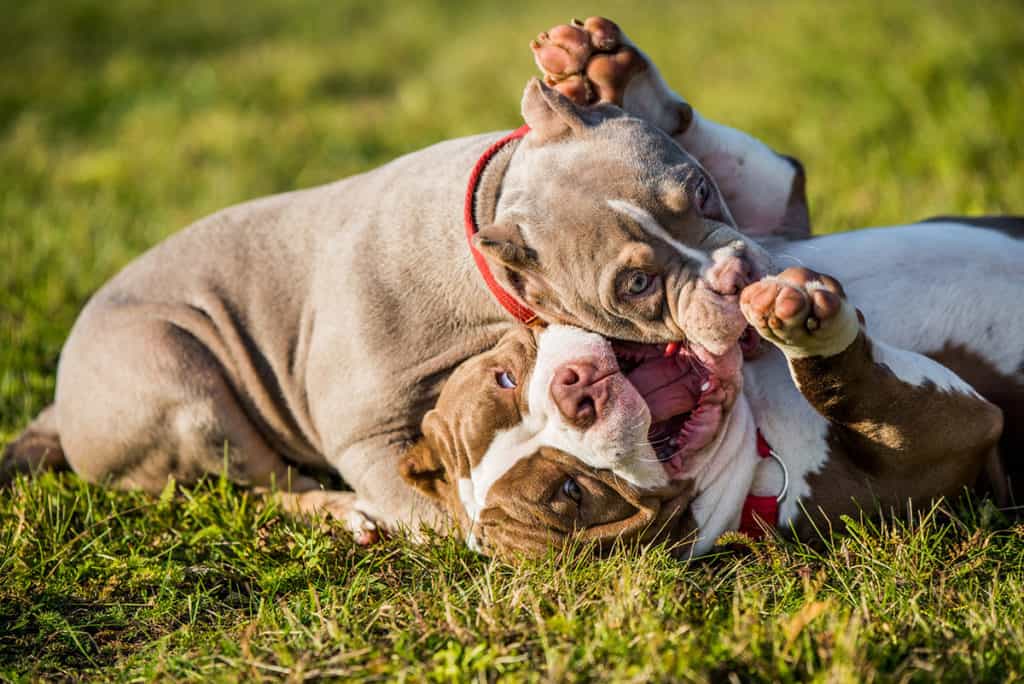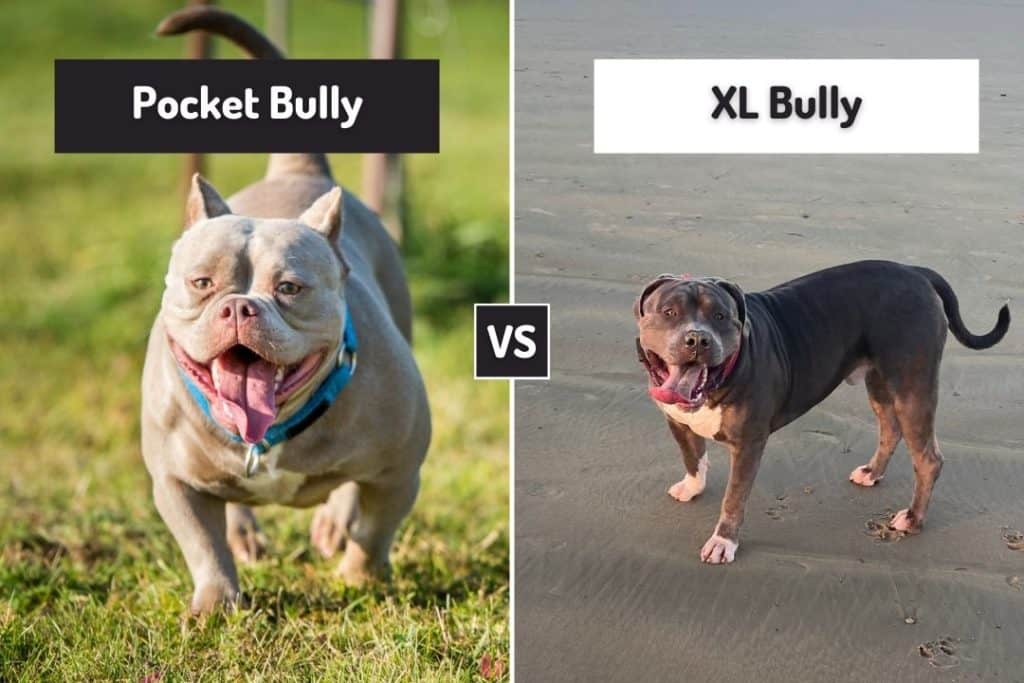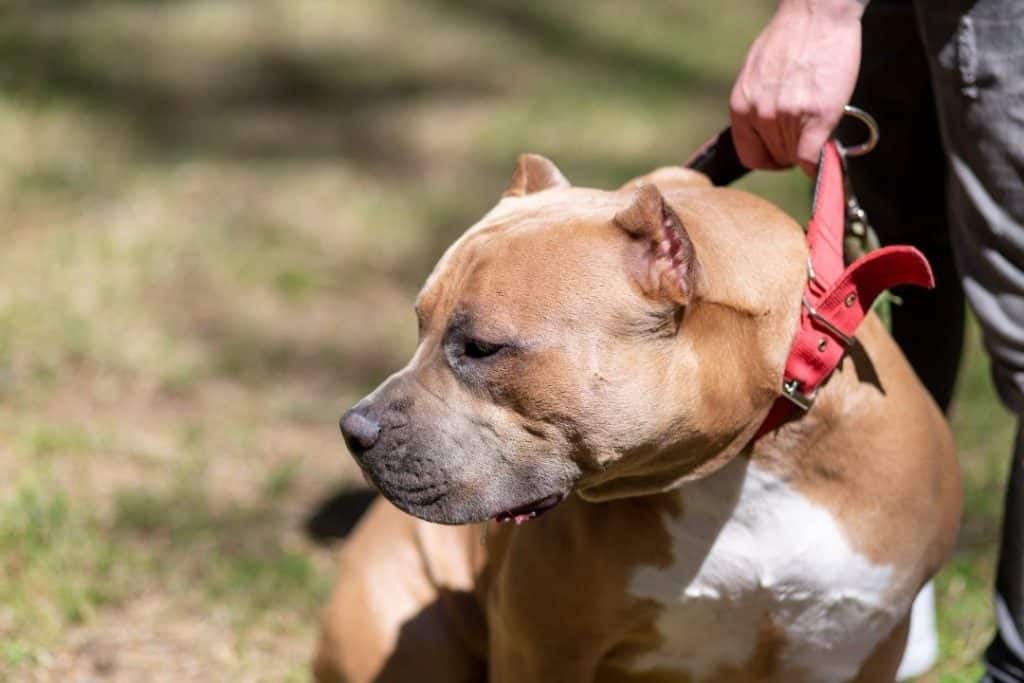This article may contain affiliate links, and I will be compensated if you make a purchase after clicking on my links (at no additional cost to you)
Bullies are some of the most popular pets in the US. However, many pet parents still struggle to distinguish the Pocket Bully from other American Bullies. So what are the main differences between the American Bully and the Pocket bully?
Pocket Bully is the smallest American Bully class known for its portability due to its tiny stature. Other American Bullies are the Standard, Classic, and the XL, with their physical size being the basis of their classification.
In this article, I’ll discuss the main differences between the American and Pocket Bullies while also providing tips on caring for these charming canine companions.
Pocket Bullies Are the Smallest of the American Bullies
The main difference between the American Pocket Bully and other Bully breeds is their physical size. Size is the main determinant of how the breed is classified.
An adult male Standard Bully measures between 17 and 20 inches (43 to 51 cm), while a female is between 16 and 19 inches (41 to 48 cm). Classic Bullies share the same height as Standard Bullies but have well-defined jaws and are less muscular and thick.
The XL Bully is the largest, with males measuring between 20 to 23 inches (51 to 58 cm) and females between 19 to 22 inches (48 to 56 cm). They have the same muscular build as the Standard Bully but are taller and have more body mass.
The American Pocket Bully is the smallest of the American Bully breed. It is short, with a male height of between 14 and 17 inches (36 to 43 cm), while a female is 13 and 16 inches (33 to 41 cm) high.
But don’t let the short stature fool you. Pocket Bullies have a firm and stiff body and are highly muscular, which can be a sight to behold.
All American Bullies Need at Least an Hour of Exercise
Being muscular and built up, American Bullies are generally an energetic breed that requires daily exercise to use up all their energy.
The recommended exercise time is at least an hour, meaning you must be willing to spare some time to take your four-legged family member out for a walk or keep him engaged in play.
However, other American Bullies may have more physical demands than Pocket Bullies due to their larger sizes.
Is the American Bully the Same As Pocket Bully?

The American Bully breed is a comparatively new breed developed in the 1980s.
The American Bully isn’t the same as Pocket Bully. An American Bully is a cross of the American Staffordshire Terrier, American Pit Bull Terrier, and other Bully and non-bully breeds. Meanwhile, the Pocket bully is a cross of the American Staffordshire and the American Pit Bull Terrier.
American Bullies have a muscular and sturdy look, which explains why they’re often mistaken for pit bulls.
However, this assumption is not true as, although energetic, American bullies are gentle and affectionate pets. They’re not as aggressive as pit bulls and enjoy running and playing with children, making them an ideal family pet.
American Bullies are categorized into four classes; the Standard, Classic, XL, and the Pocket, with their physical size being the basis of their classification. The Pocket Bully is the smallest and can be easily carried around.
Therefore, the pocket bully is the same as the American Bully, with the main difference being its distinct, smaller stature.
How Big Do Pocket Bullies Grow?
Pocket Bullies can grow between 11 to 22 lb. (5 to 10 kg), with a female weighing between 10 to 20 lb. (4.5 to 9 kg). The Pocket Bully can get the same signature fierce muscular look as the larger American Bully breeds despite its small stature.
A mature Pocket Bully will have a shallow but broad chest, a wide and large head, a low back, and short, muscular legs.
From the name, new pet parents might assume the Pocket Bully can be carried in pockets, which, of course, is not the case.
However, these cute but muscular dogs can easily be carried around due to their small size, weighing less than 22 lb. (10 kg), and with a height of fewer than 17 inches (43 cm).
American Bullies Are Easy To Groom
American Bullies do not need any special grooming. The charming dog breed has a short coat that is easy to groom, with brushing needed at least once a week. Even with the short coat, American Bullies still shed, though the amount of shedding will vary from dog to dog.
You’ll also need to regularly clip your dog’s nails and clean their ears to keep them in tip-top condition.
As expected, American Bullies are likely to struggle during cold weather due to their short coats. But you can make your best friend a lot more comfortable by keeping it extra warm throughout winter.
Tips for Taking Care of an American or Pocket Bully
Whether you have an American Bully or a Pocket Bully, you want to make sure your canine companion is healthy and happy. Caring for the two types is similar since they’re both technically American Bullies. So follow the below tips on caring for your Bully:
Check on Your Dog’s Diet
If you get to own an American Bully, it’s imperative to understand the dietary requirements of the breed.
American bully puppies require foods rich in fat and protein for both muscle and bone growth. The Taste of the Wild Pacific Stream Puppy Recipe is an example of good food as it contains real fish and high protein levels to support joints, bones, and your pup’s lean muscles.
Bullies need a similar balanced nutritional diet, but XL Bullies will require significantly more calories due to their large size.
The Nulo Freestyle Grain-Free Salmon & Peace Dry Dog Food is a great option for your adult Bully, as it contains niacin and vitamin B6 from lamb that supports energy production.
A proper diet also boosts immunity, reproductive function, and your furry companion’s lifespan. Healthy gums, teeth, and body muscles are also maintained with a healthy diet.
Do Regular Vet Visits
Generally, the American Bully is considered a healthy breed. However, since all dogs are prone to different medical conditions due to body size or genetics, it’s important to take your American Bully in for regular checks.
American Bullies are prone to neuronal ceroid lipofuscinosis, a nervous disorder causing retinal discharges and swelling.
The larger American Bullies are also prone to Hypothyroidism, where the dog’s thyroid glands do not produce enough thyroid hormones. Other common diseases include Hip Dysplasia, a hip joint malformation, heart disease, and eye problems such as Cherry eye and Glaucoma.
To be on the safe side, you should visit your trusted vet regularly to keep your canine companion away from the treatment table.
Give Your Bully Plenty of Exercise
Unlike pit bulls, American Bullies are not aggressive, though they are muscular and full of energy. They, therefore, need to exercise to channel that energy out.
An hour of exercise or daily walks should be enough to expend energy. If you live in an apartment or don’t have large yard space, you can take regular walks or invest in toys to keep your four-legged family busy.
Start Training Early
Ideally, you should train your puppy as early as possible to ensure it blends well with the family and its new environment.
You should do the first training commands at an early age in brief sessions of 5 to 10 minutes. Rewarding your dog when it responds well to your command will also make training effective.
Bullies, in particular, respond well to reward-based commands.
American Bullies are affectionate and loving, and socializing them with different people and other family pets will make them more welcoming and responsive to harmless strangers.
Wrapping Up
American Bullies are often confused with pit bulls and mistaken to be aggressive. On the contrary, they are fun-loving and affectionate pets that enjoy spending time with their family members.
Your Bully’s muscular and energetic nature requires regular exercise to prevent it from becoming destructive.
And since Bullies are naturally prone to medical conditions such as Hypothyroidism and Hip Dysplasia, it’s best to invest in a proper diet and visit your vet regularly.

I created this blog to share my passion for bullies, and help current and future pitbull owners with things like diet and education.
Hope you find it useful, don’t hesitate to drop a comment on my articles!



